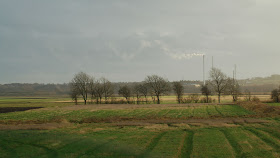 |
| Albæk church, ab. 5 km northeast of Randers. |
Albæk parish , Støvring herred, Randers amt.
The church in Albæk has a choir and nave, a tower to the west and a porch at the south side. The choir and nave are from the Romanesque period, built in limestone ashlars upon a plinth with a bevel and above is a round arched frieze, which is only kept in the choir, and lesenes at the corners. The walls were later partly rebuilt, especially in the nave, and a corniche in small red bricks was walled on. From original windows are one in the choir gable, one in the north side of the choir and two in the south side of the nave brought to light in a thorough restoration of the church 1937-38; most of these windows have kept the old wooden frame in the lighting. The north door is bricked up and partly destroyed by a newer window. The south door is in its original place, but has later been remade with a flat curve. A column base, which earlier was in the porch, might indicate that the church had a column portal.
The choir arch is kept inside. The choir, which is remarkably awry in relation to the axis of the nave, got a cross vault in the late Gothic period. The broad western tower is also from the late Gothic period. It is built in blank wall of monk bricks with a vaulted bottom room, which opens to the nave in a round arched arcade and with a pyramid roof, where the weather vane's year 1750 refers to a repair. The whitewashed porch is also from the late Middle Ages with permanent bricked benches and a high stepped gable. The nave had in the Renaissance period got a flat curved barrel vault with stikkapper, resting on wall pillars. (a stikkappe is a lesser vault-piece, cutting into the vault above a door or window).
In the restoration 1938 were found some late Gothic frescoes, some of them coat of arms of the families Bølle, Skade, Banner. It seems that the walls of the nave were covered in frescoes, a few were found at the southside: the saints Elisabeth and Katharina. According to the coat of arms the frescoes seem to origin from ab. 1400.
 The bricked communion table with a simple oak cross is from 1938. The earlier altar painting from 1864 hangs upon a wall of the nave. The pulpit, with a carved year 1619, has pillars with decoration- and arcade fields in the original decorations, which was re-discovered in 1937-38; in the fields are fru Kristence Viffert's coat of arms. A Romanesque granite font with double lions and a baptismal dish with the year 1624. Upon the wall of the nave hangs a memorial of herredsfoged ( bailiff) Peder Nielsen Østrup (+ 1653) and wife. A door wing with old mounts between nave and porch. A church ship, the brig "Peters Minde" from ab. 1878.
The bricked communion table with a simple oak cross is from 1938. The earlier altar painting from 1864 hangs upon a wall of the nave. The pulpit, with a carved year 1619, has pillars with decoration- and arcade fields in the original decorations, which was re-discovered in 1937-38; in the fields are fru Kristence Viffert's coat of arms. A Romanesque granite font with double lions and a baptismal dish with the year 1624. Upon the wall of the nave hangs a memorial of herredsfoged ( bailiff) Peder Nielsen Østrup (+ 1653) and wife. A door wing with old mounts between nave and porch. A church ship, the brig "Peters Minde" from ab. 1878.Buggesholm belonged earlier to Dronningborg rytterdistrikt (military ), but was bought for private ownership in 1766. In 1870 it was bought by Søren N. Skjødt of Skjødtsminde, whose family has owned it since. In 1932 it was taken over by Niels Skjødt.
In Østrup was once a bishop's manor. It was probably here the Århus bishop Svend in 1191 got the sickness helsot (plague). Ab. 1205 the Århus bishop confirmed that one third of the tiende ( a tax) from the bishop's manor in Østrup had to go to hr. Gødes præbende ( to the priest), which pope Innocens III confirmed in 1207. Several bishops have issued letters from the manor. Some of the vasals at Østrup were: 1460-69 hr. Niels Christensen (vinranke-Munk), who was the brother-in-law of bishop Jens Iversen (Lange); 1478-79 his son Jens Nielsen (Munk); 1491-1537 Jakob or Joakim Lykke, a sister's son of bishop Eiler (Bølle) in Århus: After this Østrup came to the Crown, it was endowed in 1537 to Mourids von Herlug and was in 1547 transferred to Dronningborg vasalry.
 |
| countryside, Albæk |
Voldstedet, the castle bank of Østrup lies almost in the middle of Albæk village, cut through by the socalled Borggyde (a small street). West of this lies a four sided low castle islet, which moat is kept to the north and west. East of the street Borggyde is a lower placed square where the National Museum in 1913 did some test excavations on a foundation of a cellar. There was a large square room and lesser out-buildings to the north and west, all built in ashlars and raw granite boulders and monk bricks in the late Middle Ages. There was also a building once at the castle islet, but the foundation was almost gone since a farm was built on the place.
Niels Jonsen of Albæk is mentioned in 1374.
There are no listed prehistorics in the parish, but there was a round dolmen, a long dolmen ( Stenhøj) and a hill (Grønhøj), all under Østrup manor.
At the eastern end of Østrup forest is a kitchen midden.
Source: Trap Danmark, Randers amt, 1963
Translation: grethe bachmann
Photo Albæk 2009,2011: grethe bachmann
No comments:
Post a Comment
Thank you for visiting my blog!